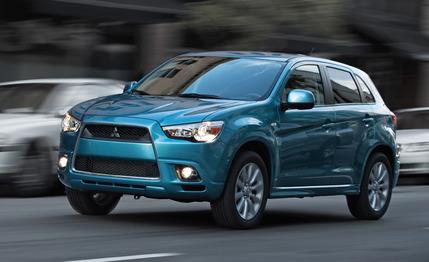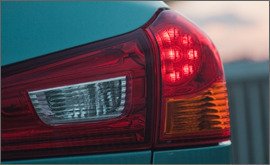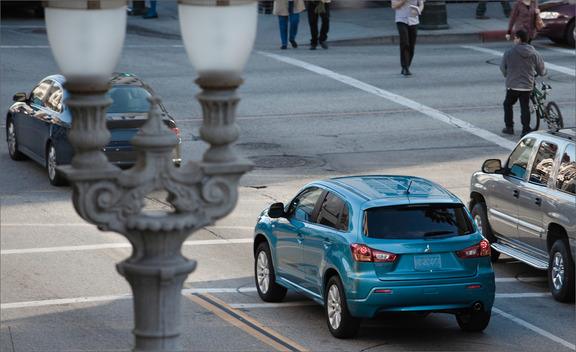 First Drive Review
First Drive Review
In its ongoing struggle for relevance—and maybe a sale or two—Mitsubishi is adopting a family approach to its models. Each nameplate will be offered in more than one variant, the Lancer line providing an excellent example of this strategy. It extends from mild—the basic Lancer DE sedan, starting at $15,535—to wild—the 291-hp Lancer Evolution X, an all-wheel-drive street tiger starting at almost $35,000. Mitsubishi is now taking this approach with the Outlander, introducing a smaller, two-row sibling, the Outlander Sport.
More Than a Badge Job—and Less
Although the Sport shares its structure, Evo-inspired front-end styling, and 105.1-inch wheelbase with the standard Outlander, it’s not the same vehicle with a different badge. It shares no sheetmetal with the regular Outlander, is significantly smaller in all its exterior dimensions, and boasts superior aerodynamics. The Sport ditches the Outlander’s optional third-row seat and eliminates the fore-and-aft adjustability of the second row.

More than 14 inches come out of the Outlander’s overall length—14.6, to be exact—for a new shadow 169.1 inches long. Width has been trimmed 1.2 inches, to 69.7; and the roofline is 1.9 inches lower, at 64.2. As you might expect, substantially reduced dimensions pay off at the scales. Expect the Sport’s curb weight to be about 3100 to 3300 pounds, or roughly 400 fewer pounds than a similarly equipped Outlander’s.
Thrifty Sport
With a much lighter vehicle, you might also expect increased performance, but there’s a caveat. Unlike the standard Outlander, there’s no V-6 engine option here. The standard (and only) engine is Mitsubishi’s all-aluminum 16-valve, 2.0-liter inline-four, mated to a five-speed manual transmission or a CVT with paddle shifters that allow the driver the illusion of six speeds. The engine is rated for 148 hp and 145 lb-ft feet of torque (143 and 143 in vehicles sold in California), and Mitsubishi anticipates an EPA highway fuel-economy rating of 31 mpg.
Even with the Sport’s lower curb weight, 148 hp is not enough to generate anything approximating face-distorting acceleration. The Sport is a little quicker with the slick-shifting five-speed, but if you want four driven wheels, you’ll find yourself manipulating the CVT’s paddle shifters, as Mitsubishi offers no manual option with all-wheel drive. This is not entirely a bad thing. The magnesium shifters are generously sized and fixed to the steering column—rather than twirling with the wheel—which makes them easy to find during quick maneuvers. The shift responses can’t match those of a dual-clutch automated manual, but they’re not sluggish, either, and lend a little something to the fun-to-drive quotient.
What’s Your Hurry?
However, in this context, the word “sport” is stretched pretty thin. As with most crossovers, that part of the equation is embodied not by the vehicle but by the stuff you take with you. The Outlander Sport features slightly lower spring rates than the regular Outlander—in deference to its reduced weight—which pays off in smooth ride quality. Although we got little seat time at this preview drive, we left with an impression of decent feel and precision from the electrically boosted power-steering system, relaxed responses, quiet operation, and good traction from the electromechanical all-wheel-drive system—virtues, for sure, but not the kind of attributes we associate with sporty driving.

Dynamics notwithstanding, the Outlander Sport figures to be an attractive buy. All its safety features—stability and traction control, anti-lock brakes, and front-side, driver’s-knee, and curtain airbags—are standard equipment. Other standard gear includes air conditioning, a tilting and telescoping steering column, cruise control, power windows, heated power mirrors, power locks with remote locking, and audio controls mounted on a leather-wrapped steering wheel.
The Outlander Sport will be available in two trim levels: ES and SE, the former starting at about $19,000, the latter at about $22,000. The ES is front-wheel drive only and can be had with the manual transmission; the SE is available in front- or all-wheel drive and only with the CVT. Maxed out with all the options—a 710-watt, nine-speaker Rockford Fosgate audio system; a panoramic sunroof with mood lighting; the Fuse hands-free media interface (similar to Ford’s Sync); Sirius satellite radio; HID headlamps; and upgraded trim inside and out—Mitsubishi says an Outlander Sport’s Monroney shouldn’t exceed $25,000. That’s an attractive price for an attractive crossover, a combination of virtues that makes the Sport a welcome addition to the Outlander family when it arrives in November.